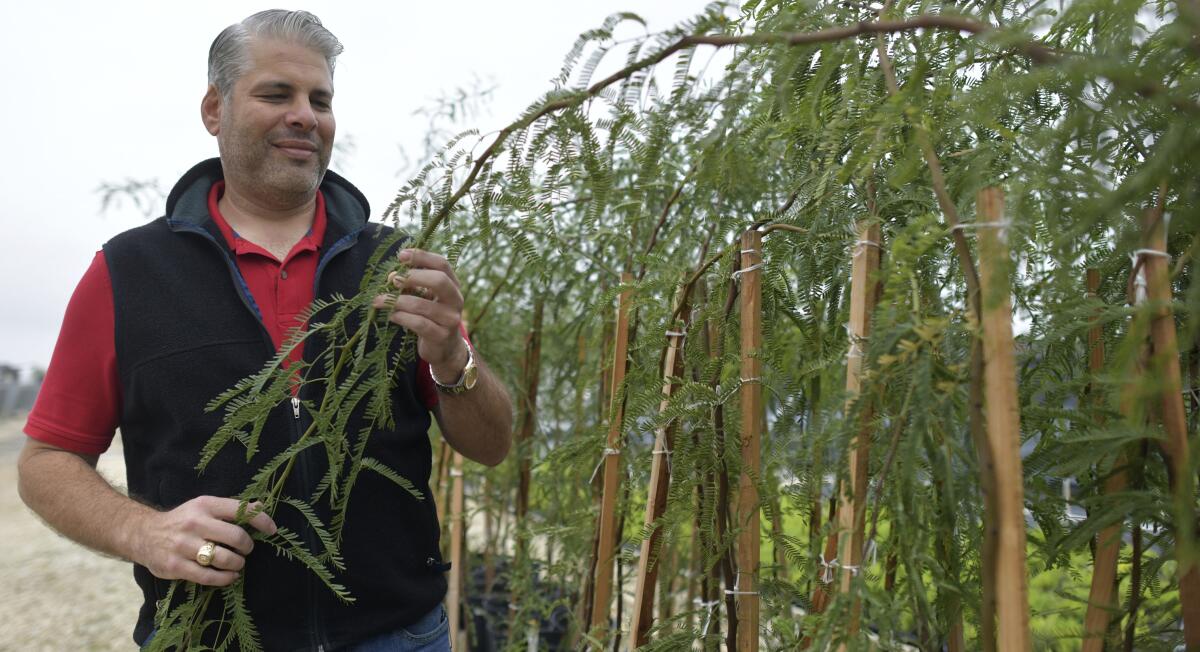Mesquite trees seen as blessing, curse in parts of Texas

Ranch manager Farron Sultemeier calls the mesquite a blessing and a curse.
The San Antonio Express-News reports this most iconic of Texas trees is a blessing because the beans provide late summer feed for cattle and wildlife, as well as being a welcome shelter and shade from the burning sun.
And the curse? Mesquite spreads ridiculously fast and is almost unstoppably invasive.
“They’ve got such a deep root system that if you cut one down, it grows back stronger and more fiercely,” said Sultemeier, who manages ranches in Uvalde, Kendall, Mason and Gillespie counties. “Given the chance, they can get so thick they cut off grazing land.”
Texas mesquites also produce thorns sharp enough to injure livestock and puncture a car tire. And they grow so gnarly and twisted, the wood is virtually useless for anything other than the outdoor pit where it imparts a bold smokiness to meat — a signature of Texas barbecue.
But that soon may change with two new and improved mesquite trees developed by California-based Altman Plants, which operates a sprawling, 500-acre wholesale nursery on the far West Side.
These experimental trees — only about 2,000 exist so far — grow erect, spineless and fast, while still being able to survive and thrive the in harsh, semi-arid climate of South Texas.
Altman Plants recently shipped about 150 of its two experimental hybrids — dubbed Mojave and Sonoran — from California to the San Antonio nursery where they’ll be propagated. Specimens should be available for purchase within a year.
These trees grew from seeds resulting from the cross pollination of two patented parents, one a rare and thornless Texas mesquite, the other a cold-hardy mesquite from Argentina that also was thornless.
While there are only four species of mesquite native to the United States — and just one in Texas — Argentina has 27.
The hybrids could represent a new revenue stream for beleaguered Texas ranchers, a way for homeowners to brighten their yards with something distinctive yet familiar and an option for municipalities looking for drought-resistant trees to plant on marginal lands.
The mesquite long has played a role in Texas lore. Classic Texas author J. Frank Dobie wrote that the tree is “as native as rattlesnakes and mockingbirds, as distinctive as northers, and as blended into life of the land as cornbread and tortillas.”
The first barbed wire fence posts were made of mesquite and, when San Antonio started paving its streets in the 1880s, it was with hexagonal mesquite blocks — at least until people started pulling them up to use for winter firewood.
Already about 6 feet tall, these trees eventually will grow to 25 to 30 feet, according to Chris Scott, the San Antonio nursery’s sales manager.
“We hope to convince ranchers to grow them as a cash crop and for homeowners to plant them as ornamentals,” Scott said. “They may open up some great opportunities.”
Mesquite wood is known for its hardness and stability, making it popular for use in furniture and flooring. But because the trees grow in such a twisted way, it’s not generally available in long boards, and so supplies tend to be limited. These new trees with their straight trunks and limbs could resolve that problem.
Now all it takes is ranchers willing to grow them.
Peter Felker is a California scientist whose passion is in developing a better mesquite tree, something he’s been striving toward since the 1970s, and on which he collaborates with Altman Plants in his spare time.
Felker estimates a rancher would spend about $600 per acre to plant 45 smaller hybrid mesquites. After 20 years or so, he or she could make between $15,000 and $20,000 per acre by harvesting the mature trees and selling the wood for lumber.
While Robert Lyons, extension range specialist with the Texas AgriLife Research and Extension Center in Uvalde, called Felker’s estimates “reasonable,” he questioned whether many experienced ranchers would dedicate that much land for such a long-term payout.
“There might be some younger guys open to something like that, however,” he said. Mesquite wood is highly prized, he explained, and the trees could be planted to help reclaim land cleared for oil and gas production.
For Sultemeier, the trees sound promising, although he said he’d need to see hard data before he’d recommend them to the owner of the ranches he manages.
“Diversification is an important tool in making ranching profitable,” he said. “So I guess I would consider it.”
Another benefit for ranchers is that mesquite is a member of the legume family so that, as it grows, it adds nitrogen to the soil, improving pasture fertility. Felker has a photo of a grove of mature Argentinian mesquites, the ground beneath them thick with forage grasses.
“The exact same thing happened on the Texas A&M Kingsville experiment station,” he said. “So in lumber plantations after seven or eight years, the grazing rates should also substantially increase.”
The hybrid trees also are hardier than native mesquites, able to survive freezing temperatures.
“We’re going to be testing them in a plot in Waco, but for now we know it can survive as far north as Austin,” Scott said.
The trees are the result of years of work by Felker, who said he has evaluated thousands of trees over that time. He was able to grow 15 seedlings from the Texas-Argentinian cross pollination. From those, he selected the two — the Mojave and Sonoran — with the best characteristics.
“By the time they were only 30 inches tall, I knew I had something special,” he said of the two hybrids they eventually settled on.
The trees’ upright growth and feathery, fernlike foliage also is expected to make them attractive to homeowners. Of the two, the Mojave trees have a more compact canopy, with leaves that grow closer together than the Sonoran.
“They don’t need a lot of water, so they’ll work in a xeriscaped yard,” Scott said. He estimated that a tree in a 5-gallon container will sell for $45 to $50; one in a 15-gallon container for $100 to $125.
Their drought-hardiness also may make them appealing to cities looking to increase their tree canopy. Los Angeles bought 1,000 of the first batch of mesquites for the city’s tree-planting program while Caltrans, California’s department of transportation, bought about 30 to plant along a highway project in Imperial Valley where summer temperatures reach as high as 107 degrees.
“They did well there,” Felker said.
So if the good news continues, ranchers like Sultemeier someday may see mesquites as more of a blessing than a curse.
___
Information from: San Antonio Express-News, http://www.mysanantonio.com
Top headlines by email, weekday mornings
Get top headlines from the Union-Tribune in your inbox weekday mornings, including top news, local, sports, business, entertainment and opinion.
You may occasionally receive promotional content from the San Diego Union-Tribune.




